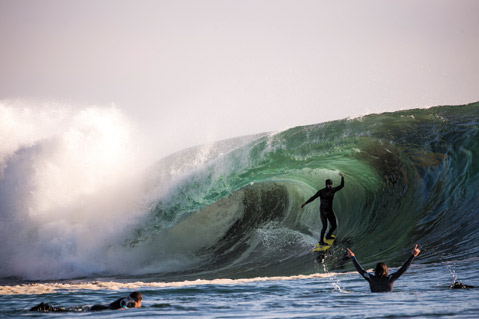Wet Suits Made from Dry Shrubs
Patagonia Creates Gear Using Drought-Tolerant Biorubber Plant

Outdoor equipment company Patagonia has been rethinking traditional wet suits since 2006, and its latest contribution to the $40 million domestic market is a once-secret recipe for making them from a shrub that grows in the drought-stricken American Southwest.
The indigenous plant is called guayule (pronounced “why-you-lee”), and its biorubber is harvested by Arizona-based Yulex, a company specializing in hypoallergenic biomaterials, from latex-alternative condoms and surgical gloves to adhesives and paints.
Partnering with Patagonia, Yulex developed a wet suit composed of 60 percent guayule-based biorubber and 40 percent traditional neoprene, a petroleum-based material with toxic ingredients. By open-sourcing this blend, Patagonia is hoping not only to make alternative wet suits more affordable in a competitive market but also to green the industry, according to Jason McCaffrey, the company’s director of surf.
“The world doesn’t need another $900 wet suit, and I didn’t see how we were going to change the industry without sharing the technology,” McCaffrey said. “For competitive pricing, we need volume; to gain volume, we need acceptance; to gain acceptance, we need to wipe all excuses for not using the product. By giving it away, I think we opened the door for all of these to happen. We’ve priced the suits competitively, and volume is slowly increasing through our own efforts and soon from other wet suit companies.”
While surf giants Rip Curl and Hurley declined to comment, Quiksilver’s wet suit production manager, Chris Gonzalez, said the plant-based material is a “viable alternative” to traditional neoprene. “We’ve met with Yulex to see where we could potentially implement the technology into our winter 2015 wet suit range,” he said, adding that Quiksilver design teams gathered recently to discuss “final decisions on how and where to best utilize Yulex.”
The material hasn’t gained acceptance across the board, however. “I love the idea, and I want to keep an open mind to it,” said John Hunter, an O’Neill senior product developer who’s been with the wet-suit old guard for 30 years. “I’m pretty picky when it comes to hand, stretch, and warmth. [This technology] definitely has potential, but there’s room for improvement. It’s not quite up to par yet with our standards.” Hunter added that O’Neill is presently developing its own neoprene alternatives.
“I’d say there is no compromise with the Yulex suit,” said pro surfer and Patagonia ambassador Keith Malloy. “At Patagonia, function comes first, so we had to make sure Yulex could preform at the highest level before giving it the green light. When I visited the farm fields in Arizona, I was blown away by these desert shrubs and [what] little water [they required],” Malloy added. “What a breakthrough.”



